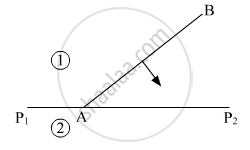Advertisements
Advertisements
प्रश्न
Explain the construction of plane wavefront using Huygens’ principle.
उत्तर

a. A plane wavefront is formed when point of observation is very far away from the primary source.
b. Let PQR represent a plane wavefront at any instant. According to Huygens’ principle,all the points on this wavefront will act as secondary sources of light sending out secondary wavelets in the forward direction.
c. Draw hemispheres with P, Q, R…. as centres and ‘ct’ as radius. The surface tangential
to all such hemispheres is P1Q1R1…. at instant ‘t’. It is a new wavefront at time ‘t’.
d. The plane wavefronts is propagated as plane waves in homogeneous isotropic medium.They are parallel to each other.
e. PP1N1, QQ1N2, RR1N3 are the wave normals at P, Q, R respectively. These wave normals show the direction of propagation of plane wavefront.
f. The new wavefront P1Q1R1 is parallel to primary wavefront PQR.
APPEARS IN
संबंधित प्रश्न
On the basis of Huygens' wave theory of light prove that velocity of light in a rarer medium is greater than velocity of light in a denser medium.
What is the shape of the wavefront in the following case?
The portion of the wavefront of light from a distant star was intercepted by the Earth.
State Huygen's principle.
Consider a plane wave front incident on a thin convex lens. Draw a proper diagram to show how the incident wave front traverses through the lens and after refraction focusses on the focal point of the lens, giving the shape of the emergent wave front.
Using Huygens’ principle, verify the laws of reflection at a plane surface.
Using this principle draw a diagram to show how a plane wave front incident at the interface of the two media gets refracted when it propagates from a rarer to a denser medium. Hence verify Snell's law of refraction.
Use Huygens’s principle to explain the formation of diffraction pattern due to a single slit illuminated by a monochromatic source of light.
Huygens' principle of secondary wavelets may be used to
(a) find the velocity of light in vacuum
(b) explain the particle behaviour of light
(c) find the new position of a wavefront
(d) explain Snell's Law
Derive the law of reflection using Huygen’s Wave Theory.
Define the term wavefront. Using Huygen’s wave theory, verify the law of reflection.
Answer the following question.
Define the term wavefront. Using Huygen's wave theory, verify the law of reflection.
Define the term 'wavefront of light'. A plane wavefront AB propagating from a denser medium (1) into a rarer medium (2) is incident of the surface P1P2 separating the two media as shown in fig.
Using Huygen's principle, draw the secondary wavelets and obtain the refracted wavefront in the diagram.

What is the phase difference between any two points lying on the same?
Wavefront means
Huygen's conception of secondary waves ______.
For light diverging from a point source ______.
- the wavefront is spherical.
- the intensity decreases in proportion to the distance squared.
- the wavefront is parabolic.
- the intensity at the wavefront does not depend on the distance.
Is Huygen’s principle valid for longitudinal sound waves?
Two light beams of intensities in the ratio of 9 : 4 are allowed to interfere. The ratio of the intensity of maxima and minima ______.
According to Huygens's principle, the amplitude of secondary wavelets is ______.
Using Huygen's wave theory of light, show that the angle of incidence is equal to the angle of reflection. Draw a neat and labelled diagram.
